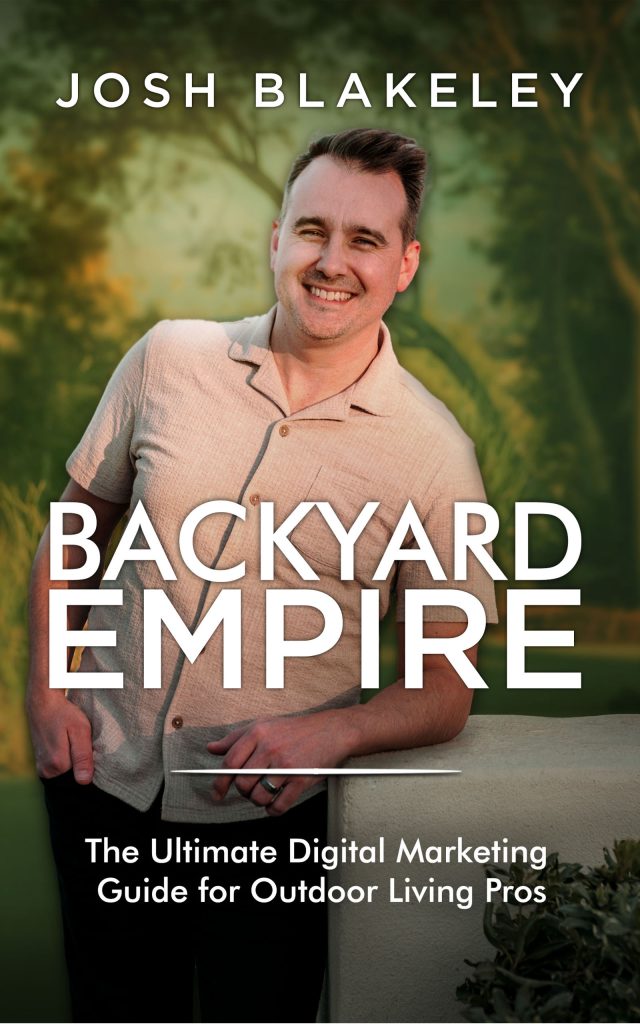Hi — I’m Josh Blakeley, owner and CEO of Landscape & Hardscape Contractor Marketing. Over the past year I’ve been helping contractors move from word-of-mouth beginnings to predictable, high-quality lead flow. This playbook distills the marketing priorities I recommend for 2025: the foundational items you must have, the channels that deliver results, and the practical actions you can start implementing this week.
Quick overview: how this playbook works
My approach categorizes tactics into three core goals: driving leads, maximizing conversions upon arrival, and optimizing for better ROI. The strategy I use with clients — the “Digital Dominance Method” — combines consistent branding, content capture, review systems, platform optimization (especially Google), short-form video, and targeted paid ads. The result is predictable: high-intent projects and profitable growth.
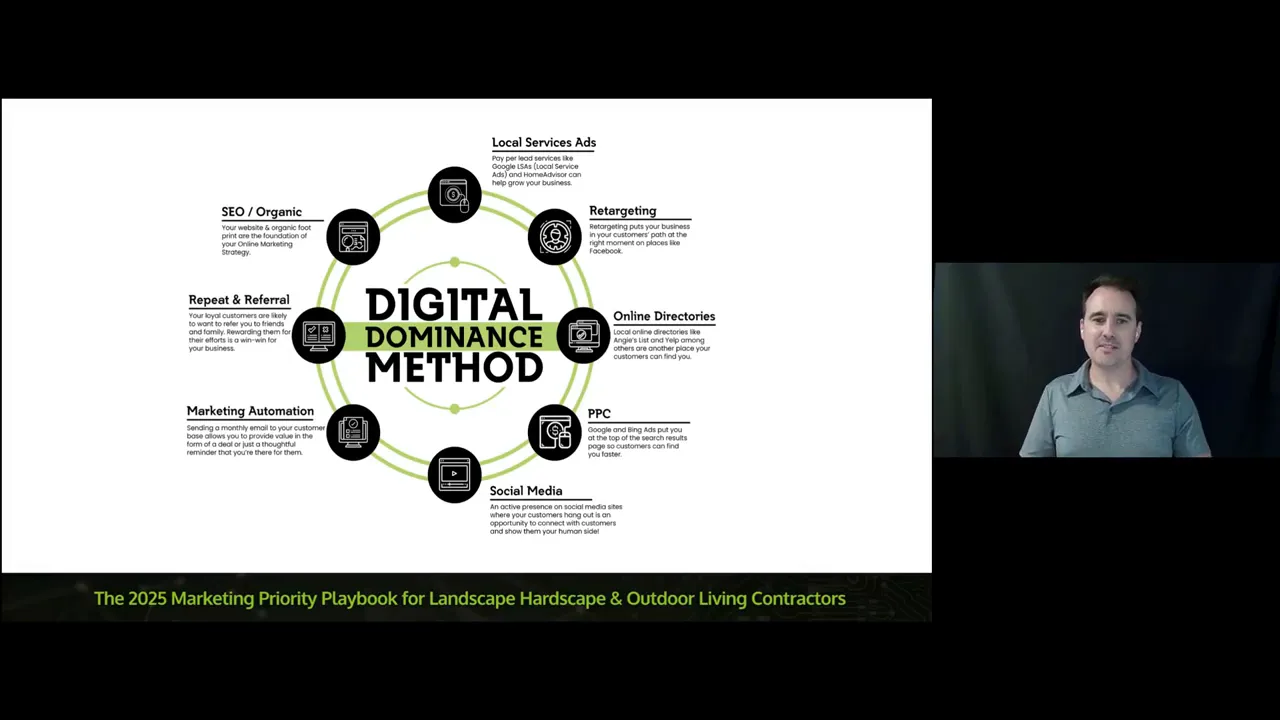
The 16-step priority checklist (at-a-glance)
- Foundation: consistent brand identity and professional email on your domain.
- Maximize job sites: yard signs, banners, door hangers, and neighborhood outreach.
- Content capture: before/during/after photos, video, drone, and testimonial scripts.
- Reviews: ask in person, use NFC cards or SMS follow-up, and track via CRM.
- Digital foundation: claim and optimize Google Business Profile (GBP).
- GBP optimization: hours, photos, services, posts and strategic address targeting.
- Website: conversion-focused, mobile-first, SEO-structured project pages.
- Social: short-form video on Facebook, Instagram, TikTok, YouTube Shorts, and LinkedIn.
- Google Ads: Local Services Ads and search campaigns for high-intent leads.
- Meta Ads: Visual Offers, Neighborhood Targeting, and Lead Pre-Qualification.
- Retargeting: use website and social pixels to re-engage visitors.
- Combine channels: create a multiplier effect (brand → search → conversion).
- Budget & timeline: invest in foundational one-time items, then scale paid ads.
- Sales systems: CRM, phone tracking, follow-up sequences, and financing offers.
- Mistakes to avoid: don’t do everything at once; track ROI and focus on visuals.
- Resources & next steps: audit, prioritize, and decide what you’ll outsource.

Step 1 — Foundation: brand and professional communication
Start with the basics: a consistent business name, logo, brand colors, and professional email on your domain (I recommend Google Workspace). Inconsistent branding or a personal Gmail sitting on the side of a wrapped van undermines credibility.
- Action: lock your business name and visual identity across every platform.
- Action: set up Google Workspace email for team members before printing vehicles or collateral.
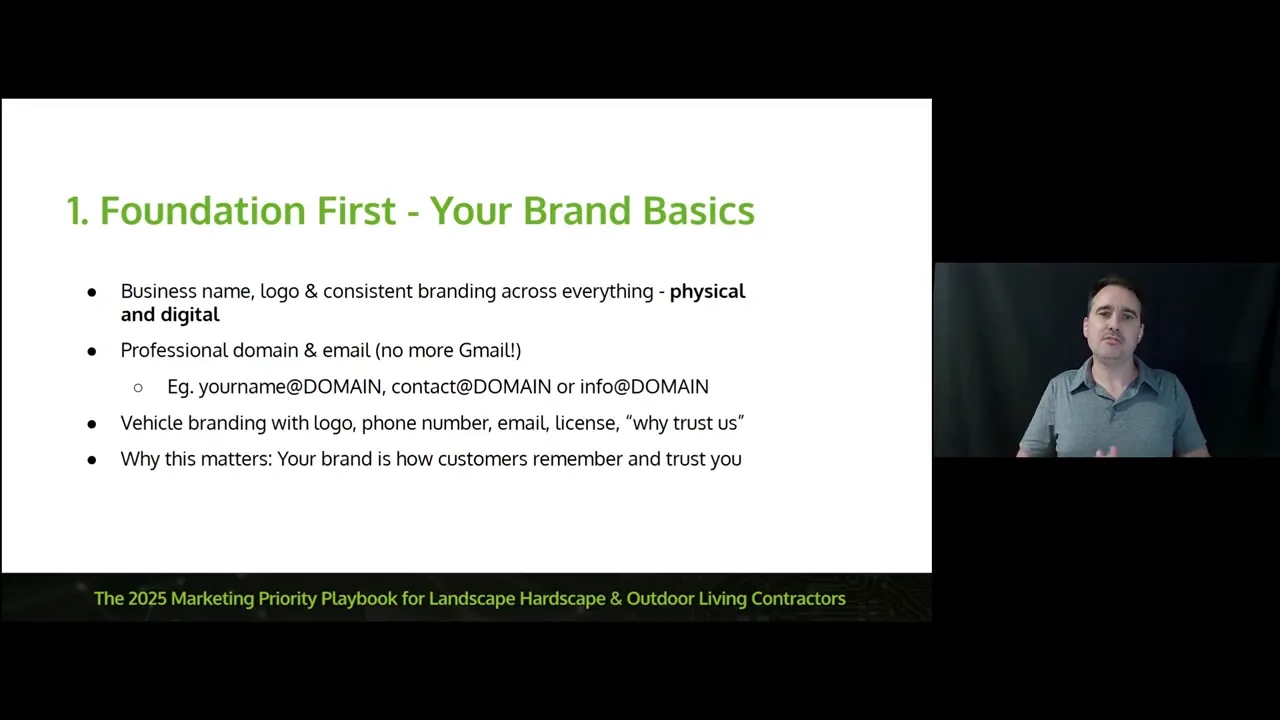
Step 2 — Maximize what you already have on hand
When you’re on a job you’re sitting in the middle of a marketing opportunity. Use yard signs, banners, and door hangers. Walk around neighboring properties, introduce your crew, and hand out a door hanger with your contact information.
- Action: order branded yard signs, banners, and door hangers.
- Action: track where calls come from — ask each new caller how they heard about you.
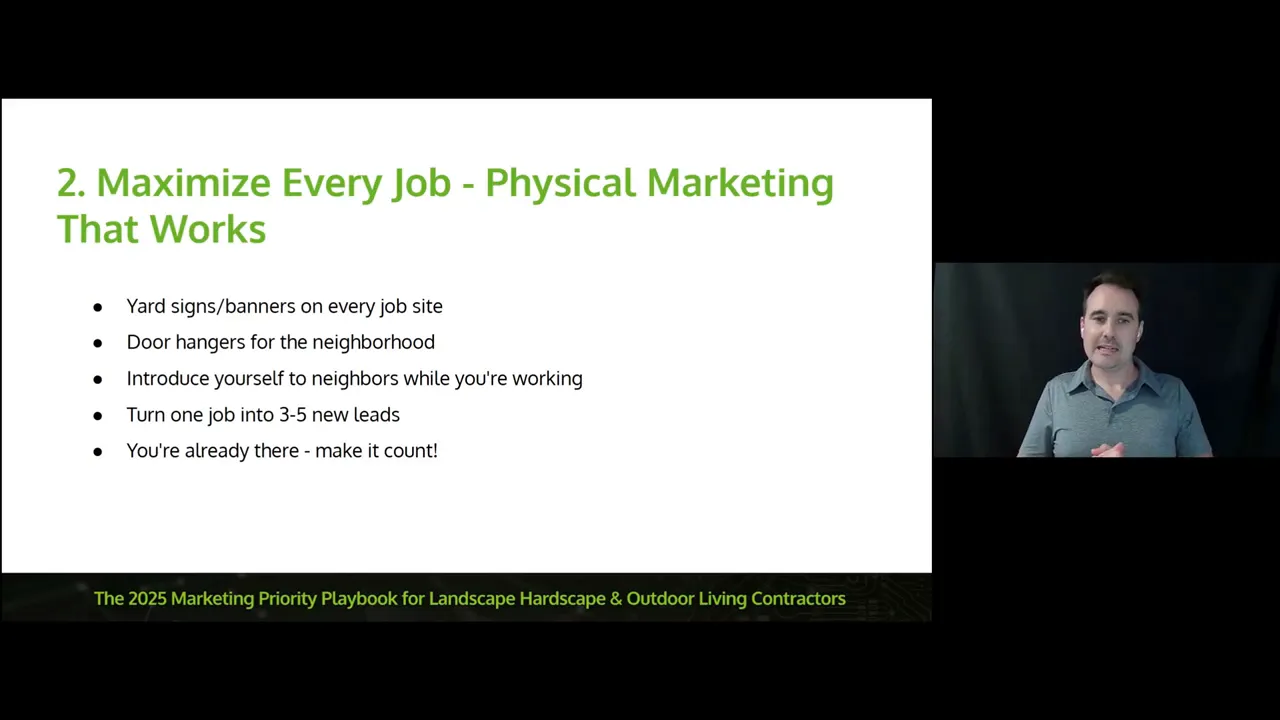
Step 3 — Capture content for every project
Content is currency. Make a job-site shot list and capture before/during/after photos, short videos, and drone shots when possible. Record short video testimonials with questions that prompt emotional reasons for hiring you (peace of mind, reliability, quality).
- Action: create a content checklist for crews to follow on every job.
- Action: store assets in a cloud drive (Google Drive) organized by project and date.
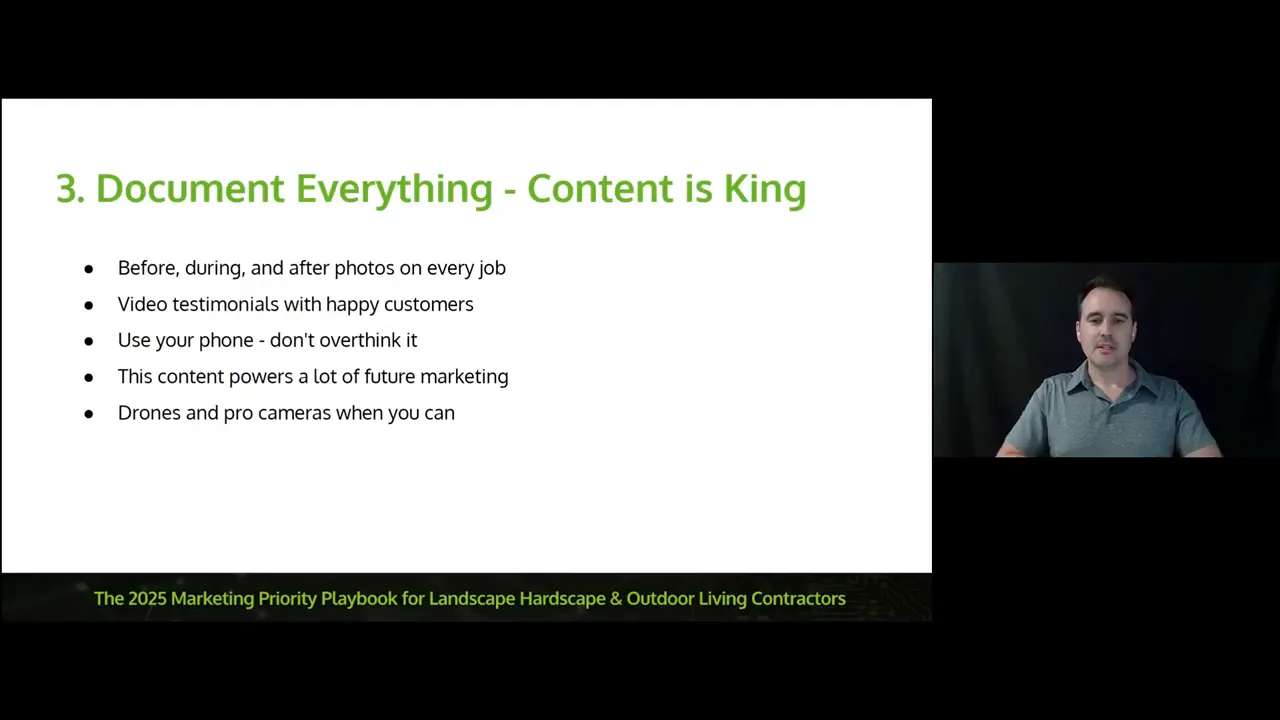
Step 4 — Reviews: ask in the moment and automate follow-up
Asking for reviews in person gets far better results than waiting. Use NFC cards or text links during the final walkthrough. If a review isn’t captured, use CRM-triggered SMS and email sequences instead. Encourage customers to mention the project type and neighborhood — that helps SEO and AI search relevance.
- Action: write a short review script for crews and office staff.
- Action: maintain a document with direct review links for Google, Facebook, and other platforms.
Step 5 — Digital foundation: Google Business Profile and directories
Your Google Business Profile (GBP) is mission-critical. Claim it, verify it, and add at least 20 photos and videos. Fill out services, a detailed business description (years in business, awards, associations, featured articles) and post offers regularly. Consider strategic address placement to shape your GBP service area “antenna” on the map.
- Action: claim and verify GBP; upload photos/videos and add services.
- Action: enable phone call tracking to measure inbound calls and use AI call analysis where available.

GBP tips that move the needle
- Keep hours long (realistic) — opening hours affect visibility in local search.
- Focus reviews on GBP first (Local Services Ads pulls reviews from GBP).
- If you’re suspended, follow Google’s re-verification requests (they may ask for video proof).

Step 7 — Website: conversion-focused and SEO structured
Your website must convert and rank. Use clear call-to-action buttons (visible on mobile devices), project case studies that tell a compelling story (embed videos where possible), and structured service pages for improved SEO. The more time visitors spend on project pages, the better your ranking signals become.
- Action: audit your site for mobile friendliness and page load speed.
- Action: build project case study pages (not just a photo gallery).
- Action: connect forms to a CRM and show clear next-step guidance after form submission.
Step 8 — Social media that actually works: short-form video
Google now surfaces “short videos” in search results — Facebook, Instagram, TikTok, YouTube Shorts and even Reddit are being referenced. Short-form content builds awareness and pre-sells your business before prospects search your name.
- Action: publish short videos consistently — start with five and build a calendar.
- Action: use a virtual assistant to post and manage local Facebook community groups.
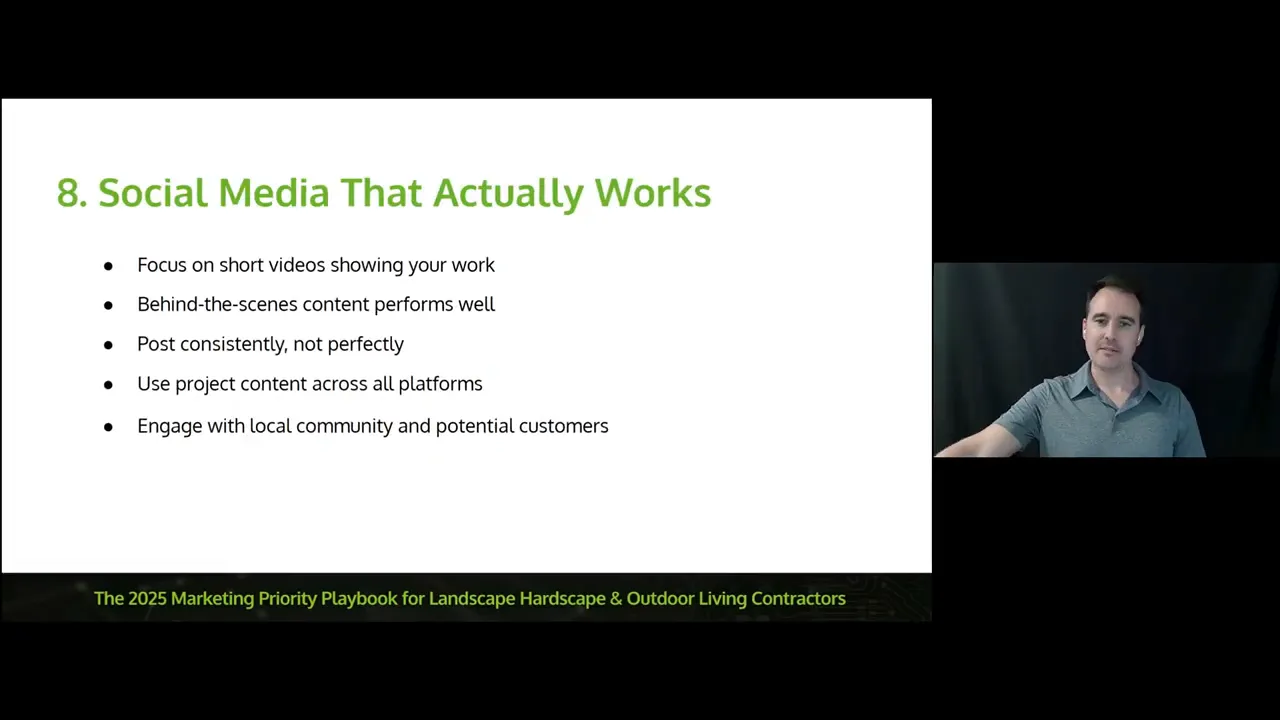
Steps 9–10 — Paid advertising: Google and Meta
Paid channels serve different purposes and intentions.
Google Ads & Local Services Ads
Search-based Google campaigns and Local Services Ads capture high-intent customers. Local Services requires GBP verification, 5+ reviews, and background checks for key personnel.
- Action: set up Local Services Ads if eligible; submit required licenses and insurance.
- Action: track which keywords turn into booked jobs — not just leads.
Meta (Facebook & Instagram) Ads
Meta is visual and creative-driven. It’s excellent for neighborhood targeting and brand awareness, but requires a lead pre-qualification process to avoid low-quality submissions.
- Action: prepare top zip codes/neighborhood lists and your best creative assets.
- Action: implement website pixels and retargeting audiences for follow-up campaigns.
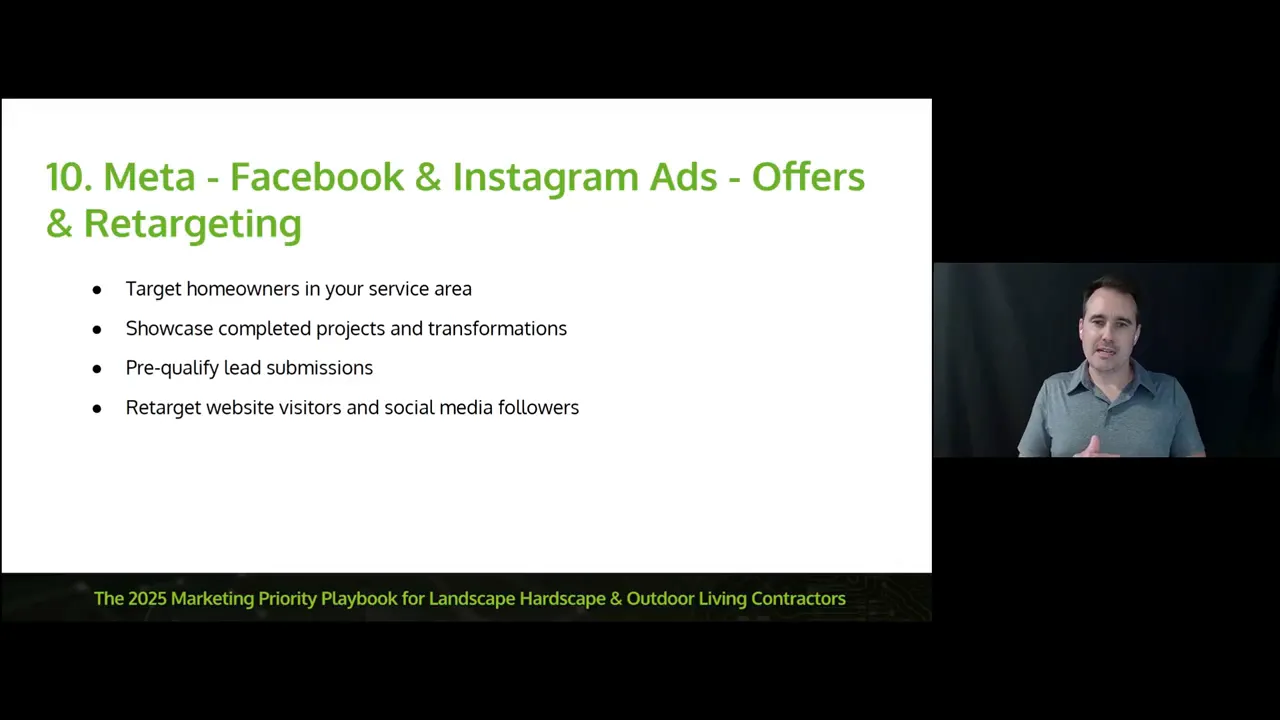
Step 11 — Combine channels for a multiplier effect
The real power comes when channels work together: a prospect sees your short video, searches your business, reads GBP reviews, visits your website, and converts. Consistent branding across every touchpoint fosters trust and higher close rates — especially for higher-end customers who conduct more thorough research before making a purchase.
- Action: map typical customer journeys and ensure every touchpoint has consistent messaging.
- Action: use a CRM to record touchpoints and measure close rates by channel.

Step 12 — Budget and timeline: invest with ROI in mind
Foundational items are often one-time investments. Printing and physical marketing are ongoing costs. Regarding ongoing marketing, the Small Business Administration guideline for landscaping companies with annual revenue under $5 million is 7–8% of yearly revenue. Use that as a starting point, but always track marketing spend and ROI — scale the channels that return profitable jobs.
- Action: categorize spend into foundational, recurring, and paid ads.
- Action: reinvest profits into the highest-performing channels.

Step 13 — Sales systems and operations
Marketing only pays off if your sales process converts leads into projects. Minimum systems: CRM, phone tracking, documented follow-up sequences, and options such as financing to increase close rates. Track close rate by channel and set lead and revenue goals tied to the projects you want.
Step 14 — Common mistakes to avoid
- Don’t try to do everything at once — prioritize and be consistent.
- Don’t use one-off visuals; the green industry is highly visual — lean into that strength.
- Don’t run complex SEO or paid ad campaigns without expertise — you can waste money.
- Do track results and focus on profitable project types, not just lead volume.

Step 15 — Resources I recommend
If you want to go deeper, here are resources I use and provide:
- Free copy of Backyard Empire (digital): https://landscapecontractormarketing.com/free-book
- Schedule a discovery call/marketing audit: https://landscapecontractormarketing.com/schedule
- List your business in the Outdoor Spaces HQ directory: https://directory.outdoorspaceshq.com/register/business
- Apply to be a guest on the Backyard Empire Podcast: https://landscapecontractormarketing.com/podcast-booking
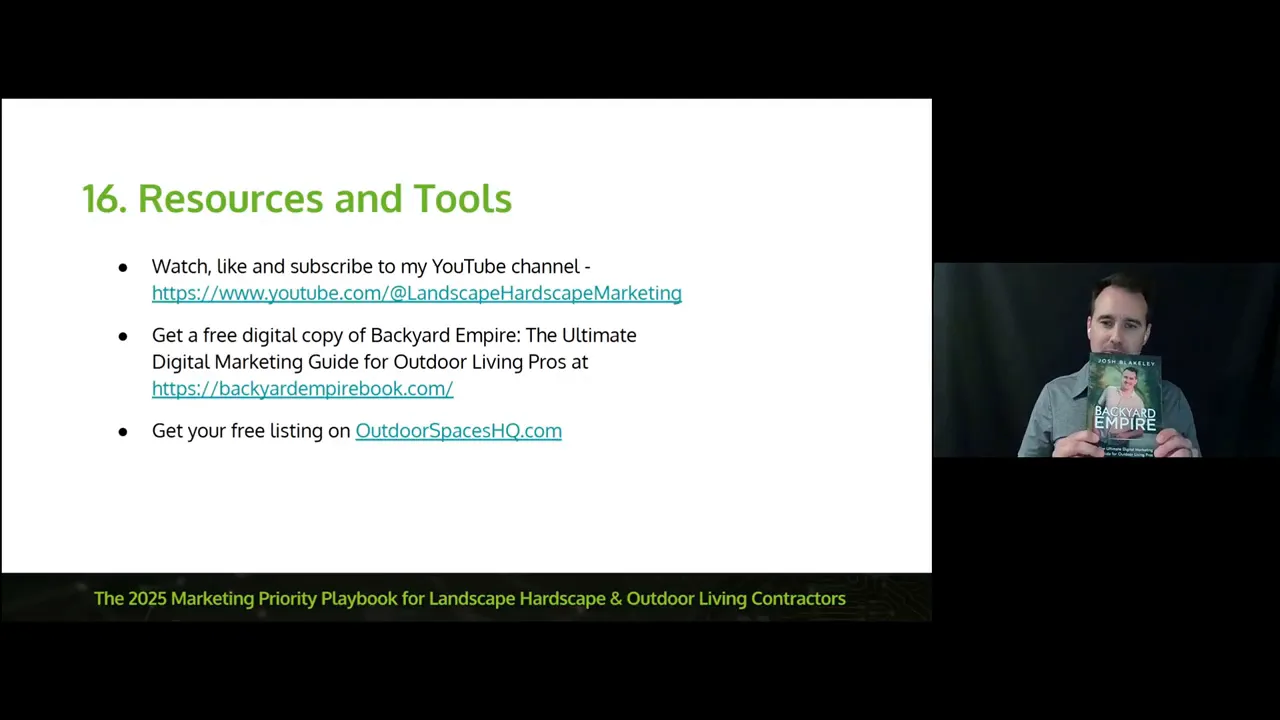
Step 16 — Your next 30-day action plan
Here’s a simple way to start applying this playbook in the next month:
- Week 1: Finalize the brand identity and set up a Google Workspace email account.
- Week 2: Claim/optimize Google Business Profile; set phone tracking.
- Week 3: Create a job-site content checklist and begin collecting photos/videos.
- Week 4: Implement a review script and CRM tracking; publish three short videos.
Final thoughts — make marketing predictable, not accidental
Marketing is an investment that pays off when it’s strategic, measured and consistent. Start with the foundation, capture great content, use reviews and GBP as pillars, and then layer in short-form social and paid channels. Track everything in a CRM and reinvest in the channels that generate profitable projects.
If you want help auditing what you already have, prioritizing the right next steps, or scaling paid channels without wasting budget, let’s talk. Book a discovery call here: https://landscapecontractormarketing.com/schedule





